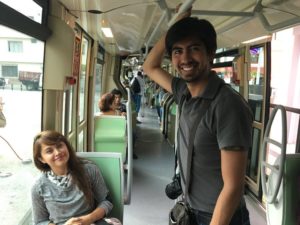How can cities and countries expand the circle of awareness about air pollution’s deadly health impacts? About fifty experts from 10 major cities and 18 countries across Latin America met 18-20 October in Medellín, Colombia at the first BreatheLife workshop. Through a series of informative panels and breakout sessions, participants considered tools and tactics ranging from communications campaigns to local assessment of air pollution-related deaths.

The meeting was organized by the WHO/Pan American Health Organization (PAHO) with the Climate and Clean Air Coalition and UN Environment. It was opened by the Deputy Minister of Environment for Colombia, Dr. Carlos Alberto Botero López, and the WHO Representative for Colombia, Dr. Gina Watson.
“Latin American cities were the first to join the BreatheLife campaign en masse, following the campaign launch a year ago,” said Dr. Agnes Soares, PAHO organizer of the event. “So it’s fitting that we have also launched our first regional action here intended to deepen and solidify knowledge about air pollution’s health effects and drive public and policy actions.”
The countries represented include Colombia, Mexico, Chile, Guatemala, Costa Rica, Brasil, Ecuador, Nicaragua, Honduras, Bolivia, Suiza, Panama, Cuba, Argentina, Paraguay, Ecuador and El Salvador.

Esthefany Cruz, who participated in trainings for both air quality and communications during the workshop, said, “We have already been engaged in the BreatheLife campaign, but this was a good workshop as we learned new tools to reinforce the campaign.” Cruz represented Jalisco, Mexico, a member region of the BreatheLife network since October 2016.
Diego Zapata is a transport planner who works for several institutions in the city of Medellín, as well as a clean air activist. He identified several challenges he’d like to see the city tackle more aggressively. “One of them is a fully integrated transport system that’s moved by electricity,” Zapata said. “That’s especially important because we produce electricity through our public services company.” The other, he said, is moving forward with the master plan for land usage. “By 2028, we’re supposed to get parks where we now find highways.”

However, despite the challenges that remain, Medellín has made enormous progress on implementing a modernized transit system, including metro, tram line and cable cars. Visitors were impressed by the transit system’s cleanliness and efficiency.
Daniel Cruz represented Bolivia’s Ministry of Environment at the workshop. He found the workshop “inspiring,” appreciating how it brought together so many Latin American countries on this major issue. He sees the same unifying effect with the BreatheLife campaign at home in Bolivia. “It’s going to be our main tool to bring together the different actors, like the environmental ministry, transport ministry and others involved. And also the different levels of the government, with municipalities and the central government.”

Cruz and his colleagues also enjoyed the opportunity to compare strategies and swap ideas with so many other air quality representatives from neighboring nations. Much of Bolivia, including the capital city La Paz, is at high altitudes, which poses a unique set of challenges for mitigating air pollution. And the health sector, he said, is approaching this issue for the first time. “So this is a very great moment, because we are taking notes on many initiatives we have found in other countries.”
Dr. Gina Watson, WHO PAHO representative, discussed the ways Colombia is integrating the BreatheLife campaign — by bringing more stakeholders to the table. “One important element here is to foster dialogue between the different sectors,” Dr. Watson said, discussing the shared investment of professionals from health, environment and economic development. “This is what we are doing: how do we bring together the different sectors, first in acknowledging that there is a problem, second that the problem can be addressed, and third, it’s an urgent need.”
Dr. Watson also touched on one of the key elements of the BreatheLife campaign: giving cities and countries the resources and support to tackle air quality challenges in their own way, using the ideas and approaches that make the most sense for their particular culture, climate, economy and level of development. “What are successful practices that have been implemented in other places that can be naturally adjusted to our environment?” Watson asked.
The first BreatheLife workshop in Medellín provided a forum and a platform for this diverse group of professionals to gather around the table — so to speak — and explore just that question.
Photo identifications from top: Discussing the way forward for air quality communications; Maricel Seeger, Organización Panamericana de la Slaud, OPS/OMS, Buenos Aires, Argentina; Esethefany Cruz and Daniel Cruz; and Diego Zapata.